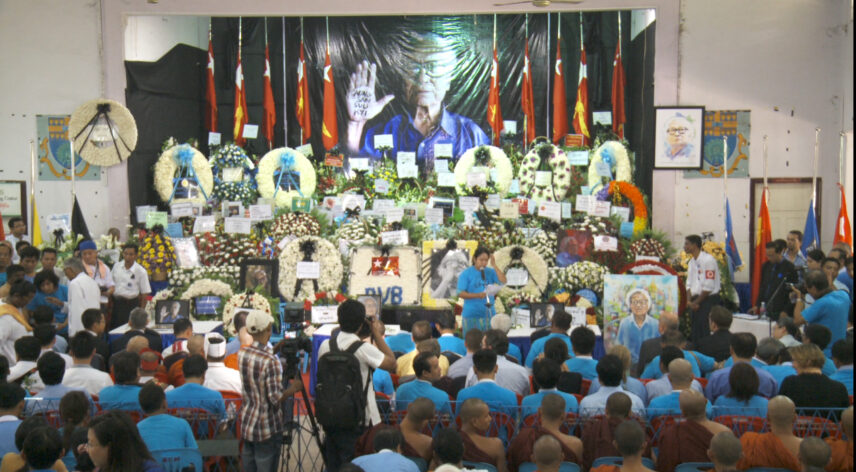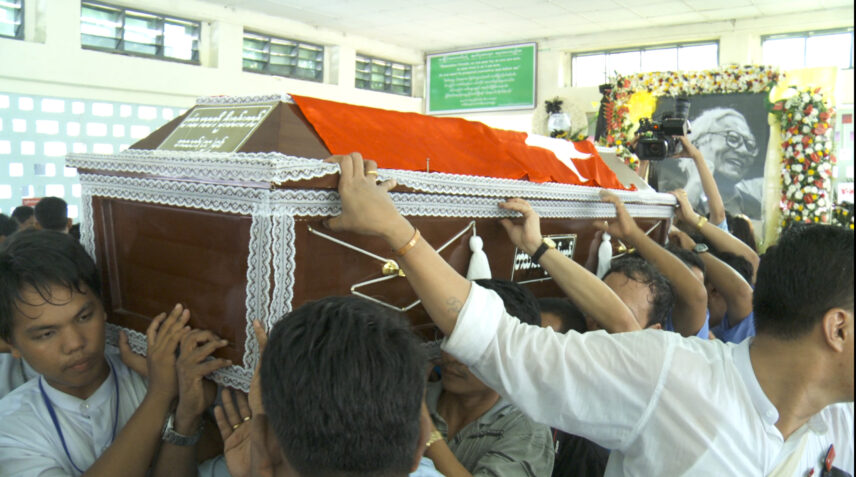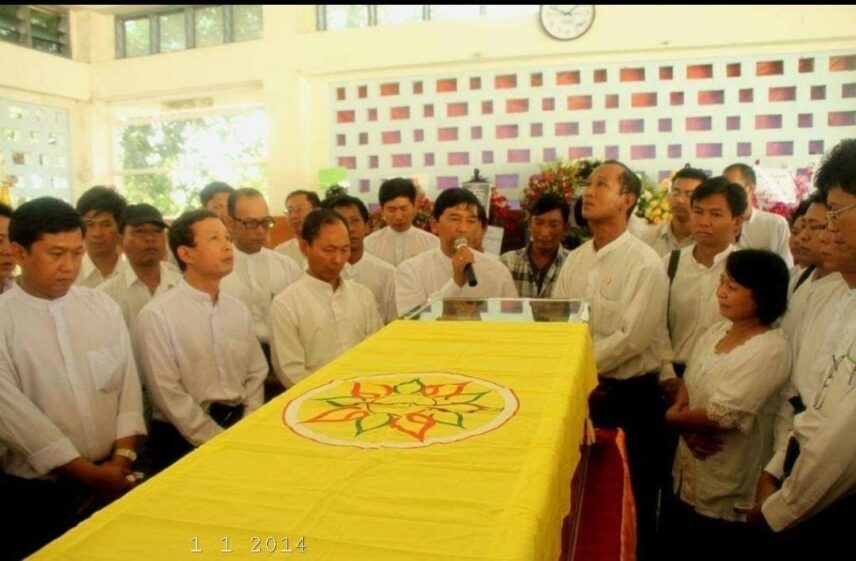Article begins
Several days before he would be executed by the Myanmar junta, the well-known democracy activist Ko Jimmy reportedly told his family, “It is not necessary to [have] a funeral in order to have a revolution.” Whether Ko Jimmy truly made this statement is unknown, but if he uttered these words, it was most certainly because he was cognizant of the fact that the military, which reseized power in a violent coup in 2021, would likely not allow his loved ones to access his body and properly lay it to rest. Indeed, when his family arrived at Insein Prison to confirm his death, the wardens would not allow them to see Jimmy’s corpse or take his remains home.
The executed body of Ko Phyo Zeya Thaw, another activist and former parliamentarian who was hung along with Ko Jimmy, met a similar fate. His mother, in an interview with BBC, stated,
I asked for [my son’s] “dead body” so that I can have confirmation of his death and they said that they cannot give it to me for regulations. And then, I asked for his bones and other remains, so that I can bury them in a tomb and they replied that it is not possible. Then I asked exactly what day and time he died. I told them we are Buddhists and that we have to perform the yetla [the Buddhist mourning ceremony performed seven days after the death] and the food offering on the third day. To this they replied that it was either Saturday or Sunday, [and that I] can estimate and do it.
The destruction of traditional funerary practices for martyred dissidents has been part of the Myanmar military’s vicious campaign against their political opponents. From 2013 to 2020, I conducted an ethnography with the community of democracy activists and former political prisoners in Yangon. Ko Jimmy and Ko Phyo Zeyar Thaw were part of this social movement community. They and other activists from groups such as the 88 Generation, the National League for Democracy (NLD), and the All Burma Federation of Student Unions (ABFSU) recounted to me how the military and its allies not only illegally detained, tortured, and persecuted their group members, but also how they forbade them to engage in meaningful rites that commemorated important dates of suffering and honored their heroes and martyrs. These attempts on the part of the Burmese military and its allies to annihilate the traditional practices of political communities across Burma need to be highlighted, alongside the more palpable destruction of lives and property. There needs to be an active campaign to counteract this ritualcide.

Ritualcide, which was first coined by Peg Levine in 2010, references the systematic destruction of traditional practices, including those that are connected to birth, illness, courtship, marriage, and death. Ritualcide often occurs in tandem with genocide and politicide. Erasure of entire peoples, whether in whole or in part, necessarily involves an eradication of their ways of life. In Cambodia, under the Khmer Rouge, suppression and alteration of spiritual practices was an overlooked crime that brought pervasive mental anguish to the people of Cambodia, depriving them of practices that had brought coherence and meaning to people’s lives for centuries, particularly in the face of death. Without traditional ceremonies, such as the Phchum Ben, the annual festival of the dead, those who lost loved ones during the reign of the Khmer Rouge were unable to establish relationships with the deceased—something considered crucial in their cosmological order.
Mortuary practices are essential to how communities cope not only with social loss but with existential dread. According to Robert Jay Lifton, funerals are “imaginative forms of transcending death.” Lifton argued that “symbolic immortality” looms particularly large for communities that have undergone or are undergoing tremendous stress or catastrophic change. Death ceremonies are evocative and powerful ways of symbolizing cultural continuity within these communities, even as they face the prospect of group extinction. Perhaps this is why funeral rites—including the right to hold those rites—have played a key role in the history of the democracy movement. Salai Tin Maung Oo, the last former student leader to be executed before Ko Jimmy, was hung in 1976 because he had participated in protests organized to give a hero his proper burial. In 1974, when U Thant, the former Secretary-General of the United Nations, passed away, the military government of Ne Win refused to give him a state funeral. Student activists took into their own hands the organizing of a funeral, including an elaborate procession. They brought the body and coffin to Yangon University. The military government eventually stormed the campus several days later, arresting thousands for disobeying their decrees.
Within the democracy movement, a hero’s burial is bestowed on those who have engaged in bodily sacrifice on behalf of the movement, typically by going through the rite of passage of the prisons. By the time someone is deemed to have made enough sacrifices to deserve a martyr’s burial, they are connected to many brothers, sisters, aunts, and uncles in the movement. These fictive kin plan the funeral alongside consanguineal kin. Often the political family oversees the rites entirely.

When political martyrs are laid to rest, there are special practices that must be observed. Written announcements promulgating the death are circulated through social media or printed with great care. Photographs, paintings, and other artistic works are put on display to honor and memorialize the deceased. T-shirts and other memorabilia are often printed to commemorate the person’s life. Comrades who were particularly close to the deceased engage in charismatic, earnest oratory.
The body of the deceased is dressed in ritual garments and placed inside a casket, the crown of which is often made of a clear material, such as mesh, glass, or plexiglass, allowing mourners to see the face of their fallen comrade. For the 88 Generation, the group to which Ko Jimmy belonged, this ritual attire would have been a white, mandarin-collared, long-sleeve shirt and a brown or black longyi (sarong). The visage of the fallen is surrounded with white and red flowers, the colors of the democracy movement. Before the casket is taken to the gravesite or carried to the pyre on the day of the ahthupa (funeral), representatives of the political groups to which the person held allegiance come forward with their flags. The first representative then steps toward the casket, drapes a flag on the coffin, and reads an official decree that releases the deceased from their attachment to that organization. This is the most mournful part of the ceremony, and it is at this point that many of even the most stoic activists break down and cry. The second representative then does likewise, and so forth until all the flags have been laid on the casket, one on top of the other, and the deceased has been released from all obligations. The papers with the edicts are placed with the body of the deceased.
It is then the biological family’s turn to prostrate before the body of the deceased. Other comrades and friends from the political family, who are moved to do so, likewise engage in the traditional prostration ritual, known as the shiko. Someone then calls out the beginning of the aleipyu, which is translated as “paying of respects” and entails bowing one’s head in honor of the deceased. Everyone present is obligated to engage in this aleipyu, a final show of deference to their fallen comrade. After the aleipyu has concluded, there is a moment of silence.
In addition to the hero’s burial, funerary rites in keeping with the religious tradition of the dissident’s family are observed by the activist community. Ko Jimmy and Ko Phyoe Zeya Thaw’s families, like a majority of Burmese, are Theravada Buddhists. Although the third day following death is when the body is buried or cremated, the incorporeal spirit of the person is not considered to yet be at rest. In what is a creative melding of Buddhist and pre-Buddhist practices, family members of the deceased open all the windows in the home so that the deceased person’s “butterfly spirit” can leave the house. The bereaved family is never left alone and both blood kin and fictive kin stand constant guard over the body, with at least one or two people (usually males) being awake at all times in case the wandering soul of the deceased is angry or hostile. On the seventh day, monks are invited to the home for a food offering ceremony and parittas are recited one last time to keep the soul of the spirit from returning to the home. The donation of food to both the monks and the many guests that come for this yetla allows the bereaved family to share the merits of their good deed with their deceased loved one, increasing the chances that he or she might be reborn into a better abode.

Previous military regimes in Burma suppressed the culture of the democracy movement in myriad ways. This ritualcide in Burma was hastened in the aftermath of the February 2021 coup. The junta began targeting the political funeral, seeking to eradicate it. Even between 1962 and 2010, when persecution of dissidents and the suppression of their culture was arguably at its height, the government did not interfere with mortuary rites.
When student activist Ko Thet Win Aung was martyred in 2006 while still serving a 59-year sentence for demonstrating peacefully against the government, there was much secrecy surrounding his death, with authorities refusing to acknowledge that he died from long-term injuries sustained during torture (he was then denied medical attention for close to a decade). Even during this dark period, the authorities allowed his family to take Ko Thet Win Aung’s body home. The prison staff shared with them the date and time that Ko Thet Win Aung had died so that they could perform both the ahthupa and yetla. It was much too risky to hold a large service, but his friends and family managed to perform the most meaningful of the rites: the aleipyu and the official edicts that released him from his duties as part of the political groups to whom he held allegiance. His brother, Ko Pyone Cho, who is also an activist and Ko Jimmy’s comrade in the 88 Generation, made it a point to go to the prison authorities and ask them to make certain that Ko Thet Win Aung’s name had been taken off the list of inmates. This was an important step for Ko Thet Win Aung to achieve final liberation from this world.
As for Ko Jimmy and Ko Phyoe Zeya Thaw, their families, friends, and many comrades were denied the opportunity to help their souls achieve true liberation. In the years to come, the military may wish that they had allowed both men to go through the martyr’s rite of releasing them from their worldly political duties. Because, without this, their spirits will continue to strive toward revolution.

